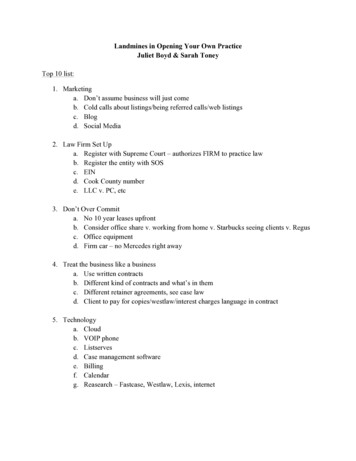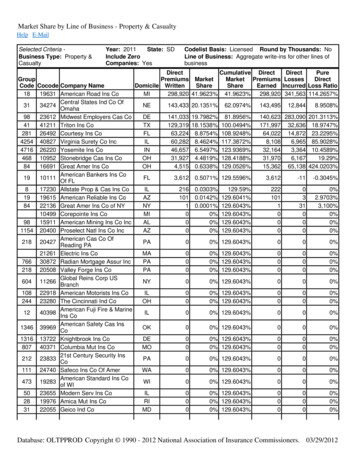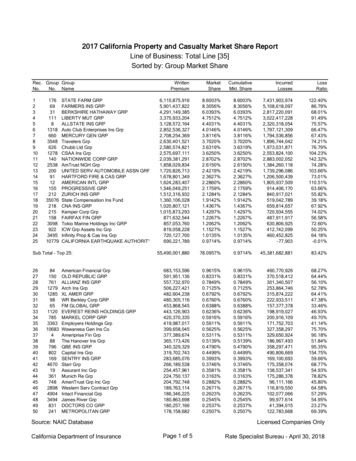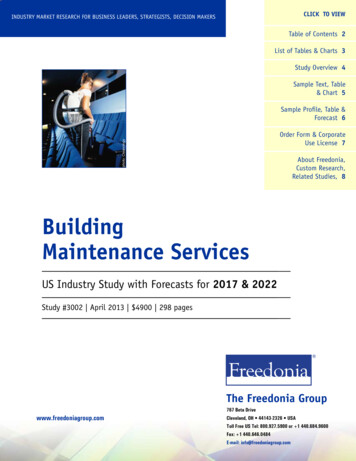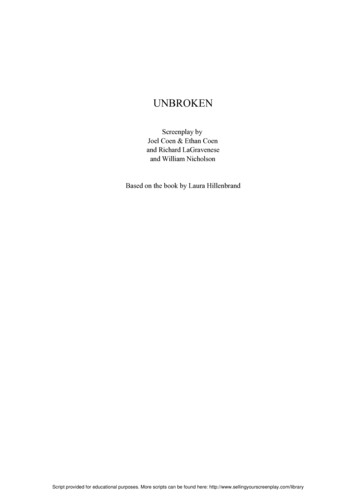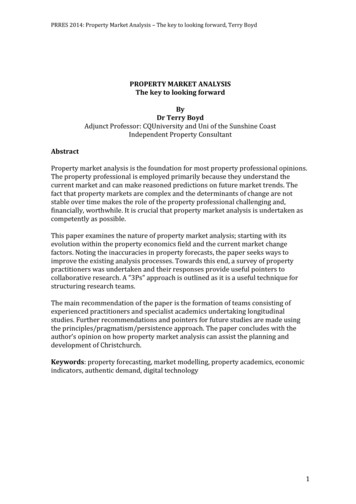
Transcription
PRRES 2014: Property Market Analysis – The key to looking forward, Terry BoydPROPERTY MARKET ANALYSISThe key to looking forwardByDr Terry BoydAdjunct Professor: CQUniversity and Uni of the Sunshine CoastIndependent Property ConsultantAbstractProperty market analysis is the foundation for most property professional opinions.The property professional is employed primarily because they understand thecurrent market and can make reasoned predictions on future market trends. Thefact that property markets are complex and the determinants of change are notstable over time makes the role of the property professional challenging and,financially, worthwhile. It is crucial that property market analysis is undertaken ascompetently as possible.This paper examines the nature of property market analysis; starting with itsevolution within the property economics field and the current market changefactors. Noting the inaccuracies in property forecasts, the paper seeks ways toimprove the existing analysis processes. Towards this end, a survey of propertypractitioners was undertaken and their responses provide useful pointers tocollaborative research. A ”3Ps” approach is outlined as it is a useful technique forstructuring research teams.The main recommendation of the paper is the formation of teams consisting ofexperienced practitioners and specialist academics undertaking longitudinalstudies. Further recommendations and pointers for future studies are made usingthe principles/pragmatism/persistence approach. The paper concludes with theauthor’s opinion on how property market analysis can assist the planning anddevelopment of Christchurch.Keywords: property forecasting, market modelling, property academics, economicindicators, authentic demand, digital technology1
PRRES 2014: Property Market Analysis – The key to looking forward, Terry BoydIntroductionI make no apology for my fixation with the need for the property professional to“look forward”. As academics or practitioners in the real property field we cannotperform our valuation, advisory and mentoring role without a constant examinationof property markets and the likely changes in these markets.Property market forecasts are, undoubtedly, one of the most challenging tasks of theproperty professional and, historically, we have not demonstrated a high degree ofproficiency in this field. We can look backwards and explain the major determinantsof past market change but we know that, over time, property markets follow anasymmetrical cyclical pattern and that it is unwise to assume that the past trendswill predict future trends.The impacts of the information and communication technology revolution combinedwith energy-driven changes ensure that future changes in the property field will begreat and, probably, have greater impact on property than any earlier period in oururbanised world.This paper evolves from my personal concern that, as an academic discipline area,property market analysis should be one of our primary research areas and that wecan improve our performance in this challenging research field. This paper will,hopefully, encourage further collaborative and long-term research in the field.The paper commences with a review of the academic research into property marketanalysis and the effectiveness of property market forecasting. This will besupplemented by commentary on the substantial practitioner activity in theproperty market analysis and forecasting field.The second section examines the current market change factors, such as authenticdemand, sustainability and the digital age, and then includes survey feedback fromsenior property practitioners. This pilot survey provides clear insight into theirperceptions of the quality of market analysis and the possible role of propertyacademics. The central section of the paper also includes consideration of “3Ps”which are useful pointers for the future.The final section draws conclusions and makes recommendations from the mainbody of the paper in order to look forward. The main recommendation relates to anew level of collaboration and also included are some thoughts on how this canimpact on the redevelopment of Christchurch.A Review of Property Market Analysis and ForecastingProperty academic and industry professionals have a long history of analysingproperty markets, with many early twentieth century pioneers stressing theimportance of real estate supply and demand (Marshall 1925; Babcock 1932;Bonbright 1937). The importance of market analysis was further developed duringthe evolution of the property discipline in the mid 20th Century (Murray 1949;2
PRRES 2014: Property Market Analysis – The key to looking forward, Terry BoydLawrence and May 1943; American Institute of Real Estate Appraisers 1951).During this period Ratcliff (1975) wrote a paper entitled “Appraisal is marketanalysis”; this focus on market analysis is still relevant today.Whilst a regular, but not substantial, number of publications on property marketanalysis have continued over the years, there has, recently, been a trend to developmore sophisticated economic models to assist the process. Researchers such asBrooks and Tsolacos (2010) have assisted in the advancement of modellingtechniques. Several recent market analysis studies appear to favour autoregressionmodelling (Hepsen and Vatansever 2011; West and Worthington 2006; Zhang andChen 2011). However the qualitative behavioural studies are also highly relevant(Gallimore et al 2000; Barnham 2008).The applicability of property market analysis studies can, to some degree, bemeasured by their ability to forecast future market movements. McAllister, Newelland Matysiak (2008) undertook an independent study of the accuracy of forecasts ofUnited Kingdom commercial property. This study found that the level of uncertaintyin capital growth forecasts was substantially greater than rental growth forecastsand that forecasters had great difficulty in forecasting yield shifts. When examiningthe success of forecasters against a naïve forecast (that assumes a “same change” inthe future), the study found that the property forecasts were, generally, notsubstantially better than naïve forecasts and that the only non-propertydeterminant that was accurately estimated by forecasters was Gross DomesticProduct (GDP).There have been several other recent studies internationally on the evolution ofproperty market forecasting (Ling 2005; Miller and Skarz 2012; Higgins 2013 and1999; Newell and MacFarlane 2006; Gallimore and McAllister 2005).In general the studies have found that the ability of the forecasters to predict themovements of the property market better than a naive forecast have beendisappointing. Higgins (2013) states:Leading property researchers have found, in many circumstances, that thetrack record of the tested property forecasters had limited predictivecapacity. (p.76)The studies also showed that, in most cases, forecasting uncertainty was a morecritical issue than forecasting disagreement and there was evidence of forecastsmoothing.Having found the disappointing outcomes by academics on the accuracy of propertymarket forecasts, I will turn to the role of the property of practitioners in my localarea - Australia, to complete the review of property market analysis and forecasting.The Australian property industry undertakes numerous empirical property marketstudies and has a wealth of data on property supply and demand, sales and rents.Property market analysis and forecasting is undertaken by property organisations(such as The Property Council of Australia (PCA), Investment Property Databank(IPD), Australian Property Institute (API), Real Estate Institute of Australia andothers) as well as individual property corporations (such as BIS Shrapnel, Colliers3
PRRES 2014: Property Market Analysis – The key to looking forward, Terry BoydInternational, Jones Lang LaSalle (JLL), Savills and many others). While somereports are restricted to paying clients and beyond the financial scope ofuniversities, many reports are available for educational purposes.The Property Council, in conjunction with IPD Australia, produces an ongoingproperty index for all property (non residential) as well as the retail, office andindustrial sectors. The database for this index, which measures investment returns,has a total asset value of 137Bil representing 1,574 assets (PCA/IPD, 2013). Theadvantages of this index are that it started in December 1984, uses quarterlyassessments, and provides income, capital and total returns. It does however rely onvaluations and the qualification of the person undertaking the valuation impacts onthe index. IPD Australia also produces a quarterly Green Property Index.There is an informative publication by API that collates the opinions of propertymarket professionals on market forecasts. It is the “Australian Property DirectionsSurvey” and it is produced six monthly by the NSW division (API (NSW), 2013).While this publication relies on the input from practitioners, it receives feedbackfrom a good cross-section of private sector professionals including bonds and fundmanagers. It provides indicators based on both the position on the property clockand the property cycle. Data has been recorded since 1999 and this report providesan overview of market sentiment at different time periods.Many major property corporations have research teams that analyse supply anddemand factors to determine net absorption and vacancy indices. In addition thesecorporations analyse sales and rental data and produce information on sales andrental prices and volumes as well as buyer profiles (Colliers 2012 & 2013; JonesLang LaSalle 2013; Savills 2012 & 2013). These research teams also providecommentary on the future outlook based on the latest analysed data. They do not, ingeneral, use econometric modelling to arrive at their market forecasts but the sales,rents, buyer-profile and net absorption figures are current and comprehensive andusually available for further research.In summary both the academic and industry sectors in Australia undertake propertymarket analysis of the major property sectors within the main urban areas as wellas some level of property market forecasting. There is an increasing availability ofthis information in the public domain and, hopefully, property students are beingrequired to review this important resource.Probable Property Market ChangesTraditionally we have been aware of the strong impact on our markets from nonproperty, economic factors such as GDP and interest rates, but there are a number ofemerging economic and non-economic factors that will influence our markets in thefuture. I consider that three of the most important emerging factors are energyusage, digital technology, and authentic demand.Energy: Much has been written about sustainability and its impact on propertymarkets. I will focus on energy as I believe it will have the greatest impact in the4
PRRES 2014: Property Market Analysis – The key to looking forward, Terry Boydfuture. Rifkin (2011) has received international reaction to his book “The ThirdIndustrial Revolution”, which has the subtitle “How lateral power is transformingenergy, the economy and the world.” He describes the five pillars of the thirdindustrial revolution as:(1)shifting to renewable energy;(2)transforming the building stock of every continent into green micropower plants to collect renewable energies on site;(3)deploying hydrogen and other storage technologies in every buildingand throughout the infrastructure to store intermittent energies;(4)using Internet technology to transform the power grid of everycontinent into an energy internet that acts just like the Internet; and(5)transitioning the transport fleet to electric plug-in and fuel cellvehicles that can buy and sell green electricity on a smart, continental,interactive power grid.Energy type, usage and storage will change and the change will escalateexponentially once it gains momentum. Already property developers areacknowledging, by their actions, the need to adapt to more efficient energy usage.Clearly this factor will have a major impact on our property markets; the thirdindustrial age will dominate our lifestyle in some form or another in the mediumterm. Resource rich countries, such as Australia, will be affected on many levels andproperty specialists should be actively monitoring the market movement.Digital technology: Informative and communicative technology changes havealready ushered in a digital technology obsession. The younger generation learns,communicates and relaxes while immersed in ICT. We see the growing impact ofonline retail activity and must examine the future needs for retail, warehousing andlogistics space. However this change will have a wide impact on all sectors of theproperty industry, not the least of which are the tertiary learning centres. Thepertinent question today is: are the universities providing the learning environment,support and facilities best suited to the younger generation in today’s world?McCallum (2013) provides a thoughtful consideration of how our world is changing.He refers to energy and ICT change, but also highlights the need to collaborate,effectively. “Collaboration is, in a sense, the DNA of the emerging networked society”(p.68).We should not concentrate solely on the economic changes, we should also be awareof societal change and a growing emphasis on health and lifestyle. Many of theseissues are covered under the sustainability banner but there is also a broadeningappreciation that not all property decisions are demand driven.Authentic demand: The concept of authentic demand, described by Pirounakis(2013, p.5), as “non-derived element, for example when the built structure and/orthe location in question have emotional, social, or brand value”. Indigenous peoplehave always considered that certain lands have cultural or spiritual value.The narrow property value concept that the value
importance of real estate supply and demand (Marshall 1925; Babcock 1932; Bonbright 1937). The importance of market analysis was further developed during the evolution of the property discipline in the mid 20th Century (Murray 1949; PRRES 2014: Property Market Analysis – The key to looking forward, Terry Boyd 3 Lawrence and May 1943; American Institute of Real Estate Appraisers 1951). During .

